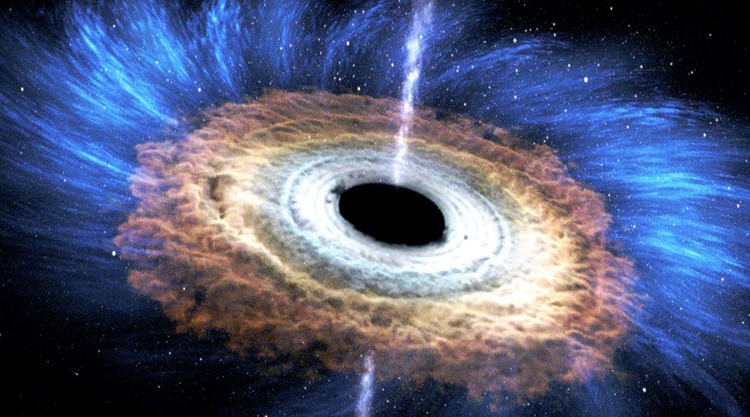The supermassive black hole is 20 billion times more massive than the Sun
Astronomers discovered the fastest growing supermassive black hole in the universe, swallowing a mass of stars the Sun two days ago.
The voracious monster black hole was discovered when the team observed the cosmic area 12 billion light-years away. They could see this black hole because it was unusually bright. If the black hole is in the Milky Way, seen from the Earth it will be 10 times brighter than the full moon, overshadowing all the stars in the night sky, according to Science Alert. The research results are published in arXiv.org magazine.

Simulate black holes glowing when eating stars.(Artwork: NASA).
Scientists estimate that the new black supermodel, named QSO SMSS J215728.21-360215.1, is about 20 billion times more massive than the Sun and constantly growing at a rate of 1% after millions of years. "The black hole is so fast that it is thousands of times brighter than an entire galaxy, due to all the gas that it absorbs every day, creates a lot of friction and heat," said Christian Wolf at the National University. Australia (ANU), team member, said.
can erase all life on Earth due to X-rays emitted when it absorbs matter. Because so many substances are absorbed, it is classified as quasar, one of the rarest and brightest objects in the center of galaxies. Quasars are determined by data from Gaia satellite of the European Space Agency (ESA), the Wide-field Infrared Survey Explorer (WISE) of the US Aerospace Agency (NASA) and telescope. ANU's SkyMapper.
Up to now, very few quasars and such large black supermasses have been found. The challenge for researchers is to find out how these objects can grow incredibly fast in the early universe.
- Video: Compare the size of black holes in the universe
- The supermassive black hole closest to Earth glows intensely
- The three galaxies unite to
- The biggest black hole collision is 9 billion light-years away
- Researchers are about to film a supermassive black hole
- The black hole can only expand to 50 billion times the mass of the Sun, it is impossible to 'eat to grow'
- Black holes can be 50 billion times more massive than the Sun.
- Super-large black hole rotates rapidly near the speed of light
- Detecting black holes 'monsters' 350 million times more massive than the Sun.
- The first time I took a picture of a black hole three million times bigger than Earth
- Detecting the supermassive black hole is spraying material
- Monster black holes are 100,000 times bigger than the Sun.
 Van Allen's belt and evidence that the Apollo 11 mission to the Moon was myth
Van Allen's belt and evidence that the Apollo 11 mission to the Moon was myth The levels of civilization in the universe (Kardashev scale)
The levels of civilization in the universe (Kardashev scale) Today Mars, the sun and the Earth are aligned
Today Mars, the sun and the Earth are aligned The Amazon owner announced a secret plan to build a space base for thousands of people
The Amazon owner announced a secret plan to build a space base for thousands of people The nearest black hole discovered is only 150 light years from Earth
The nearest black hole discovered is only 150 light years from Earth  New discovery of the oldest black hole in the universe
New discovery of the oldest black hole in the universe  The Black Pyramid and the tragedy of deep oblivion: A thousand years later, still no escape from the tragedy of tomb raiding
The Black Pyramid and the tragedy of deep oblivion: A thousand years later, still no escape from the tragedy of tomb raiding  Exploring the 'Black Box of the Earth' project: A device that records the process of human extinction
Exploring the 'Black Box of the Earth' project: A device that records the process of human extinction  Finding the mysterious 'monster' that is making the universe expand
Finding the mysterious 'monster' that is making the universe expand  Why do images of black holes appear to be burning from the outside?
Why do images of black holes appear to be burning from the outside? 